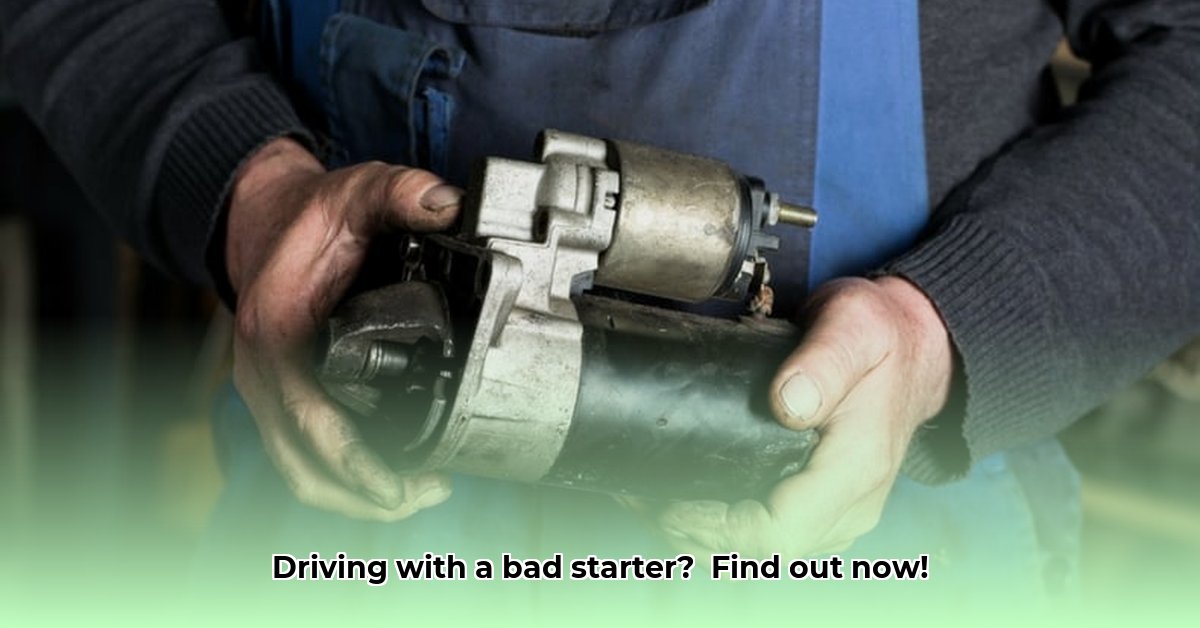
Understanding Your Car's Starter: The Engine's Ignition Key
Your car's starter motor is a crucial component, responsible for initiating the engine's combustion process. Think of it as the key that turns the engine from a sleeping giant into a powerful machine. A malfunctioning starter won't always fail catastrophically; it might begin with subtle issues before eventually refusing to cooperate entirely.
Recognizing the Warning Signs: Your Starter's Distress Signals
A failing starter often displays a range of warning signs, providing clues that allow you to anticipate trouble. Pay close attention to the following symptoms:
- Sluggish Starts: The engine cranks slowly, as if struggling to overcome significant resistance. This indicates the starter motor is straining to perform its function.
- Grinding Noises: A harsh, metallic grinding sound suggests the starter's gear isn't properly engaging with the engine's flywheel. This is a sign of potential damage.
- Intermittent Starting: The car sometimes starts reliably, and other times it fails to ignite. This inconsistency is unreliable and potentially dangerous, especially while driving.
- Clicking Sounds: A rapid clicking noise often indicates a problem with the starter solenoid (the electrical switch that activates the motor) or a low battery. However, these symptoms can overlap, requiring careful diagnosis.
The Crucial Question: How Long Is Too Long?
There's no definitive answer to how long you can drive with a bad starter. The severity of the malfunction dictates the risk. Driving with a faulty starter introduces significant risks, potentially leading to further damage and costly repairs. It's akin to driving with a flat tire – risky and potentially dangerous.
Assessing the Risks: A Spectrum of Potential Problems
The consequences of driving with a faulty starter vary depending on the extent of the malfunction. The following table summarizes these risks:
| Starter Malfunction Severity | Risk Level | Potential Consequences | Recommended Action |
|---|---|---|---|
| Slow Cranking | Low | Mostly inconvenience; may drain the battery over time. | Monitor battery voltage; consider repair soon. |
| Intermittent Starting | Medium | Potential for stranding; increased risk of starter and battery damage. | Avoid extended driving; seek professional diagnosis and repair immediately. |
| Grinding Noises | High | Risk of serious damage to the starter, flywheel, and potentially the engine. | Do not drive; immediate professional assessment and repair required. |
| Complete Failure | Very High | Immobile vehicle; risk of further, expensive damage. | Immediate towing and professional repair are necessary. |
Time for Action: Diagnostic Steps and When to Seek Professional Help
While professional assessment is always recommended, you can perform several preliminary checks yourself:
- Battery Voltage Test: Use a multimeter to measure the battery's voltage. A reading below 12.6 volts indicates a weak battery, which can mimic starter problems.
- Connection Inspection: Examine the starter's wiring and battery terminals for corrosion or loose connections. Clean corrosion and tighten connections.
- Sound Analysis: Listen carefully for unusual noises from the starter motor during attempts to start the engine. Grinding or clicking are telltale signs of problems.
- Professional Diagnosis: If home checks don't identify the problem, consult a qualified mechanic for a thorough diagnosis with specialized equipment.
Ignoring a bad starter invites escalating problems, impacting both safety and your wallet. Preventive maintenance and prompt attention to warning signs are crucial for minimizing risk and avoiding costly repairs.
How to Diagnose a Car Starter Clicking But Not Turning Over
A clicking sound when attempting to start your car indicates a problem within the starting system. This isn't always indicative of a dead battery; rather, it signals a lack of sufficient power to crank the engine. The nature of the clicking sound – a single click or rapid clicks – provides valuable diagnostic information.
Step-by-Step Troubleshooting Guide
Effectively diagnosing this issue involves a systematic approach:
- Battery Check: Inspect battery terminals for corrosion. Clean and tighten connections if necessary.
- Voltage Measurement: Use a multimeter to check battery voltage. A healthy battery should read approximately 12.6 volts.
- Cable and Connection Inspection: Inspect cables for damage, looseness, or corrosion at all connection points.
- Alternator Test: Once battery and connections are addressed, check the alternator's output voltage (it should be above 13.5 volts while running). A faulty alternator prevents proper battery recharging.
- Starter Solenoid Examination: If previous steps reveal no issues, a faulty starter solenoid might be the culprit. This often necessitates professional diagnosis. A temporary fix (not recommended) could be a sharp tap on the solenoid, but only as a last resort.
- Starter Motor Assessment: If all else fails, the starter motor itself may require repair or replacement – a job best left to qualified professionals.
The Risks of Continued Driving with a Clicking Starter
Driving with a persistently clicking starter is strongly discouraged. Repeated attempts to start the vehicle will drain the battery, leading to stranding. Additionally, continuous cranking overheats and damages the starter motor, increasing repair costs.
Don't compromise your safety. If you're unsure about any of these steps, consult a qualified mechanic for professional diagnosis and repair.